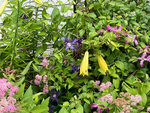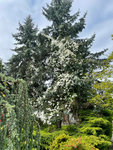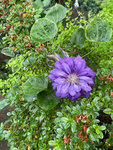



The clematis flower, known for its massive size, is a popular addition to gardens in Washington and across the country.
Washington State University Extension Master Gardener Fran Hammond has a vast knowledge on the plant that is native to Japan.
“They call (clematis) the ‘queen of the vines.’ … It’s an absolutely spectacular vine,” Hammond said. “It has so many attributes that make it a perfect plant for the garden.”
Hammond said the name of the plant comes from the Greek word, Klema, which means “vine branch.”
“The particular plant was mentioned as early as 1548, so the plant has been around for a bazillion ages,” she said.
Hammond said the plant has also been given English names like “beggar’s plant” and “traveler’s joy.” It’s part of the Ranunculaceae family. Some varieties of clematis plants climb as they grow. They can travel up items or can sprawl across the ground.
“Most of the varieties have petioles or leaf stalks, which can coil or grab onto a support, so they grab onto a support and that helps them climb,” she said.
The bloom time for the plants is anywhere from four to six weeks, which makes “it a wonderful perennial,” she said.
It can also come in a variety of shapes, she said. The plant is adaptable to different times of the month, as Hammond said it can bloom as early as February, or as late as October.
At her home in Vancouver, Hammond said she has a 75 to 100 foot tall tree that features a Montana clematis she hasn’t pruned. Reaching to almost the top of the tree, Hammond said it “makes this amazing cascade of white flowers every spring.”
“(Clematis) just makes everything more beautiful,” Hammond said. “Having that plant around just enhances our sense of well-being by being able to look at something so magnificent.”
Another attribute clematis has is its ability to grow along a variety of surfaces.
“You can put them on trees and let them go, you can put them on shrubs, you can put them on conifers. They look absolutely spectacular on roses,” Hammond said. “A lot of people will have a pink rose growing in the garden and they’ll put a white clematis going through it so it looks like the rose really has two colors with different flowers on it.”
Clematis can “scramble around on the ground” or can be supported through the use of a pergola, a trellis or other structure.
“They’re really an ideal plant for so many possibilities in your garden,” Hammond said.
A healthy plant should have good roots and multiple stems. People who want to plant clematis should look at the sun and shade requirements and determine whether they are a climbing, lax or scrambling variety.
“You want to put a little bit of rose-type fertilizer in (the) hole and mix it in when you plant them. You want to make sure you plant them deep (and) you want to always make sure they have essential water,” Hammond said. “(Clematis) is not hoggish about water, but you don’t want the roots to go dry or they will die.”
For more tips on working with clematis, Hammond recommends “An Illustrated Encyclopedia of Clematis” by Mary Toomey and “Gardening with Clematis: Design and Cultivation” by Linda Beutler.